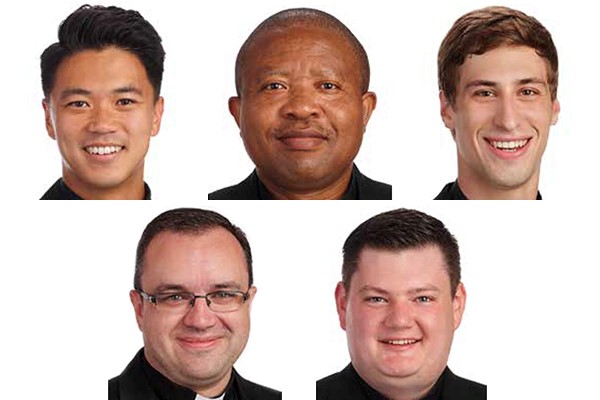
Five men will be ordained to the transitional diaconate on Saturday, April 23. They are (top, from left) Ryan Ackmann, Kenneth Anyanwu, Michael Courchaine, (bottom, from left) Joseph Heit and Kevin Tanel.
On Saturday, April 23, Ryan Ackmann, Kenneth Anyanwu, Michael Courchaine, Joseph Heit and Kevin Tanel will be ordained to the transitional diaconate for the Archdiocese of Milwaukee at the Cathedral of St. John the Evangelist in Milwaukee. With this rite, the men will become deacons — servants of the Word, liturgy and charity — but they will also embark on their final year of priestly formation in anticipation of their Presbyteral ordination next May.
The term “transitional deacon” is fitting because this next year will be one defined by the very idea of transition, said Fr. John LoCoco, vocation director at Saint Francis de Sales Seminary.
Not only will the new deacons focus more intensely on perfecting the sacramental practices that make up the priestly life — learning to preside at Mass, hear confessions and more — but they will also begin to truly exemplify what Christ said in Matthew 20:28: “The Son of Man did not come to be served but to serve and to give his life as a ransom for many.”
“I think you really start to see the man come alive in a new way and enter into his own identity as one who is conformed to Christ and called to share in his life of service,” said Fr. LoCoco of the transitional diaconate.
Here are five things to know about the transitional diaconate.
It’s more than just a precursor to Presbyteral ordination
Just because the transitional diaconate is ordered to its fulfillment in eventual ordination to the priesthood doesn’t negate the significance of this particular state. “The diaconate ordination is a necessary step (toward priesthood), but it also is something that should be celebrated in and of itself,” said Fr. LoCoco. “It has its own rites, and it really is an important day, insofar as you’re making promises of prayer, of obedience and celibacy that really begin then.”
Transitional deacons can begin to serve in a ministerial way
The five men will emerge from the Cathedral on April 23 as deacons who have assumed Christ’s yoke of service. Previously in their formation, they have been installed to the orders of acolyte and lector, but as deacons, they will have an even more important role to play in the sacramental life of the Church. “It’s important to give the man, in anticipation of priestly ordination, the opportunity to begin to serve in a ministerial way,” said Fr. LoCoco. “You begin to get swept up in the life of sacramental service.” Deacons can preach at Mass, they can give certain blessings, they can preside at funerals and help bury the dead, and they can baptize and witness marriages outside of Mass, among many other ministerial functions.
There is an intimate link between the diaconate and the Gospel
After being ordained, a deacon goes to kneel before the bishop, who places the Book of the Gospels in his hand, saying: “Receive the Gospel of Christ whose herald you have become. Believe what you read, teach what you believe, and practice what you teach.” The men are now tasked with bringing the Gospel into the world, both by proclaiming it at Mass and by exemplifying it in their service and daily life.
Once a deacon, always a deacon
“You never stop being a deacon,” explained Fr. LoCoco, who pointed out that even the Pope has the option of wearing the deacon’s dalmatic beneath his chasuble. It’s a clear sign that “service doesn’t stop once you’re ordained a priest,” he said.
There are similarities to a Presbyteral ordination, but some differences
On the surface, the ordination to the transitional diaconate bears a striking resemblance to a priestly ordination. At both, candidates lie prostrate on the floor of the Cathedral. At both, a prayer of consecration is said. At a priestly ordination, the deacon will reaffirm the promises he previously made at his transitional diaconate ordination. While priests are vested with a chasuble, deacons are vested with a stole and dalmatic. The man’s hands are not anointed at a diaconate ordination, and he does not receive the chalice and paten.
